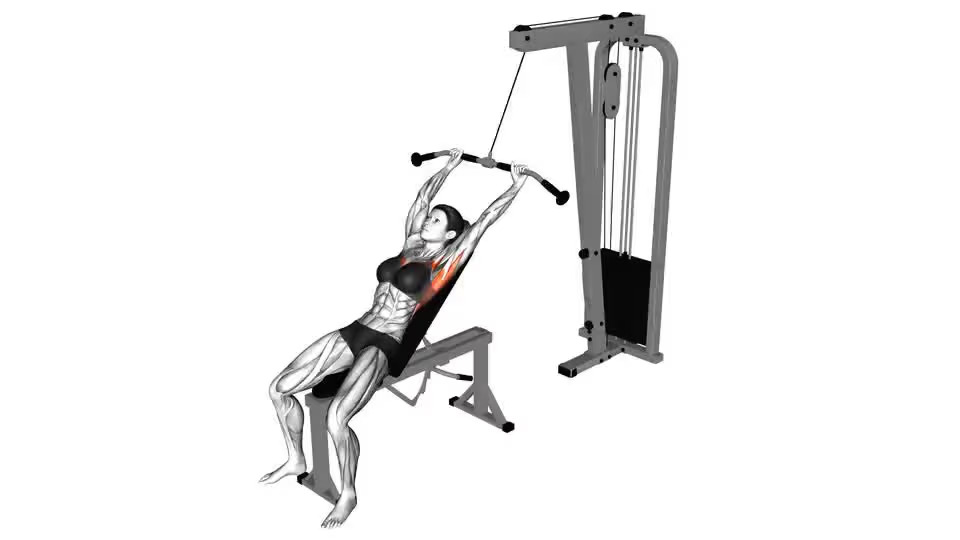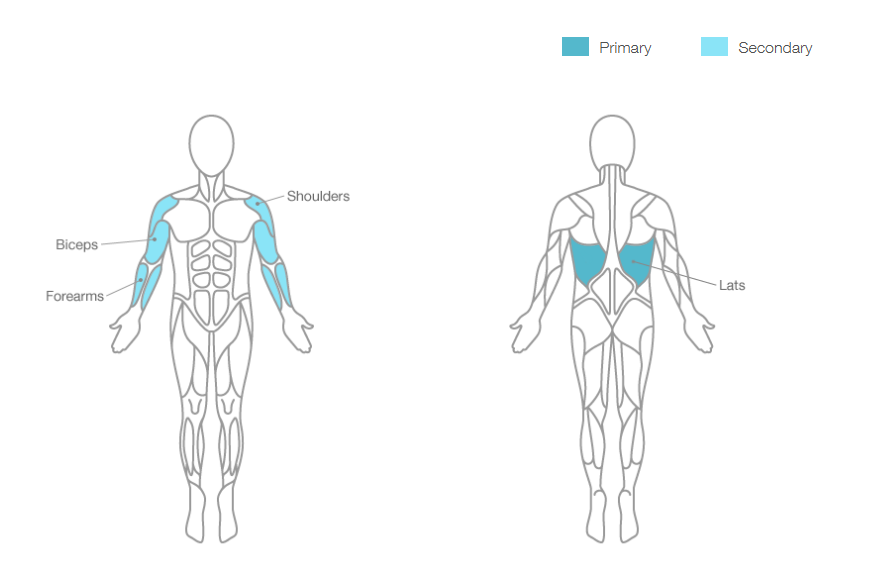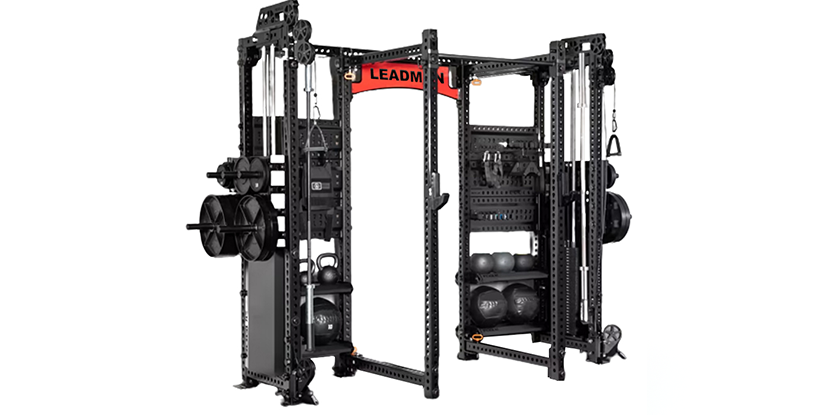The incline lat pulldown wasn’t even on my radar—until I saw a random Reddit post asking if you could pull it off lying down on a bench. At first, I kinda shrugged it off. Sounded weird. But then I started thinking… “What if it actually works?”
Figured, why not give this a go? Honestly, it looked weird at first—but hey, curiosity wins.
I played around with the angle. Tweaked my grip. Tried a few slow reps. And straight up—it felt amazing. Way more lat engagement than I expected. My biceps lit up too, but in a good way. Way less stress on my shoulders, which is always a win.
Turns out, what I thought was just an experiment is actually a legit variation. It’s called the incline lat pulldown—and now I’m hooked.
Let me show you how I set it up, what muscles it hits, and why this move earns a permanent spot in my commercial gym playbook.
How I Do the Incline Lat Pulldown
Honestly, once I figured out the setup, the movement felt super smooth.

Here’s how I dialed it in at the gym:
- First, I grabbed an adjustable bench and set it to about a 30–45° incline—not too steep, just enough to lean into the pull.
- I placed it facing the cable machine and lined it up so the high pulley was directly overhead.
- Then I sat down, planted my feet, and pressed my chest into the bench—no wobble, no sliding.
- I reached up and grabbed the lat bar with a wide grip (neutral grip also hits nice, by the way).
- From there, I pulled the bar straight down to my upper chest—slow and controlled. Afterward, I made sure to keep my elbows just slightly tucked—nothing flared or sloppy. That tweak alone made the pull feel way more dialed in.
- On the way back up? I didn’t just let the bar rocket back. Instead, I slowed it down and kept that tension locked in the whole time. Man, it honestly felt like my lats were clocking in for overtime—no joke. They were firing hard, especially during the stretch and squeeze. Surprisingly, it hit different—in a good way, obviously.
💡 Pro tip: brace that core like you mean it and glue your chest to the bench. Otherwise, you’ll be sliding all over the place and, frankly, wasting reps. It stops you from rocking around and really helps isolate the lats.
Muscles Worked
So yeah—when I added the incline lat pulldown to my gym sessions, I was mostly trying to hit my back differently. But I quickly noticed it wasn’t just the lats feeling it.

Here’s what really got worked:
Primary Muscles:
- Lats – No surprise here. The incline angle shifts the pull just enough to really light them up. It’s like a deep stretch and a solid squeeze all in one move.
Secondary Muscles:
- Biceps – My arms were definitely feeling it, especially toward the end of the set.
- Shoulders – Mainly the rear delts. They kick in more than I expected.
- Forearms – Gripping the bar tight through the full range? Yeah, these get smoked too.
👉 Overall, it hits more than just your back. That’s why it’s been a solid staple in my upper body days.
Why Incline Hits Different
Honestly, the incline lat pulldown surprised me. It’s not just a slight tweak—it totally changes how the movement feels. Here’s what stood out to me:
- First off, my torso stayed locked in. The incline bench gave me way more control.
- Secondly, no cheating. Less swing, less momentum—just clean, lat-driven pulls.
- Also, my elbows and shoulders? Way happier. The angle just felt smoother, no weird pinches.
Another thing I noticed? The angle hits your lats in a slightly lower range. Especially at the bottom of the pull—it’s like they fire up harder.
👉 All in all, it wasn’t just some goofy setup. Surprisingly, this incline move gave me more control, more squeeze, and way less joint stress. Pretty solid tradeoff, especially in a commercial gym setting where you’re chasing efficiency and results.
Extra Tips and Setup Notes
After a few sessions, I picked up a couple of things that made the incline lat pulldown even better. So here’s the good stuff:
- Go with a solid incline bench—the kind with full chest support. Too upright and it kinda messes with the angle.
- Start lighter than you think. This setup hits deeper. My lats were fried fast the first time.
- Play with grips. Personally, I liked a neutral grip—felt easier on my wrists and elbows.
- Slow down the negative. Don’t just let the bar yank back. That stretch? It’s money if you control it.
- Got a cable station with an adjustable seat? Even better. Makes setup way smoother in a busy gym.
Basically, small tweaks = big difference. Once I dialed these in, the movement felt way more locked-in and effective.
All in all, if you’re training at a commercial gym and want to level up your back game, incline lat pulldowns are absolutely worth trying. It’s a simple tweak—but man, it delivers.
FAQs about Incline Lat Pull Down
Performing the incline lat pull down requires proper setup and technique for maximum benefits and safety. Start by positioning an incline bench under a lat pulldown machine or cable system. Adjust the bench to an angle of 30 to 45 degrees, ensuring your upper body is aligned with the cable or bar. Sit on the bench with your feet flat on the floor, engaging your core to maintain balance.
Grip the bar slightly wider than shoulder-width apart, using a pronated grip with palms facing away. Pull the bar down smoothly toward your chest, keeping your elbows close to your body. Pause briefly at the bottom to feel the contraction in your lats, then slowly return the bar to the starting position. Maintain a controlled motion throughout the exercise, avoiding jerky movements or using momentum. Proper execution of this exercise effectively targets the lats, biceps, and rear deltoids for upper body strength and stability.
Leaning back excessively during a lat pulldown can compromise the exercise’s effectiveness and increase the risk of injury. A slight lean is acceptable for maintaining natural spinal alignment, but an exaggerated backward lean shifts focus away from the lats and onto the lower back. This reduces muscle engagement and may strain the lumbar spine.
To prevent improper leaning, ensure your core is engaged throughout the exercise. Keep your back neutral and avoid pulling the bar down with momentum. If you find yourself leaning too far back, it might indicate that the weight is too heavy. Adjust the resistance to maintain proper form. By keeping your posture correct and controlled, you can maximize the benefits of the lat pulldown while protecting your back from unnecessary stress.
The best angle for lat pulldowns depends on your specific fitness goals and muscle targeting preferences. For incline lat pull downs, an angle of 30 to 45 degrees is ideal for effectively engaging the lats, rear deltoids, and biceps. This incline allows for a natural pulling motion that aligns with the target muscle groups, ensuring optimal activation and strength development.
In contrast, a standard lat pulldown performed in an upright position primarily focuses on the upper and middle lats. Experimenting with different angles can help you find the most effective position for your goals, whether it’s building width, improving posture, or enhancing overall back strength. Always adjust the bench or your body position to maintain proper form and alignment throughout the exercise.
The main difference between a lat pulldown and a reverse lat pulldown lies in grip and muscle emphasis. A standard lat pulldown uses a pronated grip (palms facing away), primarily targeting the lats with secondary engagement of the biceps and rear deltoids. It focuses on developing width and overall back strength.
In contrast, a reverse lat pulldown employs a supinated grip (palms facing toward you). This variation shifts more emphasis onto the biceps while still engaging the lats. The reverse grip can also provide a greater range of motion, promoting increased flexibility and mobility in the shoulders. Both exercises are effective, but choosing between them depends on individual preferences and specific training goals.

Hi, I’m the editor here at Leadman Fitness. We’re a manufacturer focused on producing top-quality barbells, plates, kettlebells, dumbbells, and strength training gear. I’ve been into sports and fitness for years, and I know my way around all kinds of gym equipment—both from using it and helping create it.
I spend a lot of time understanding the real problems people run into in the gym—whether it’s beginners trying to pick the right gear or experienced lifters looking for something more durable. I stay in close touch with our production team and talk directly with other equipment makers, so we’re always improving based on what real lifters and coaches are looking for.
What I share comes from hands-on experience—stuff that actually helps people train better, not just in theory, but in real gyms.
